RFF on the Issues: High-speed rail development; Arctic drilling standards
High-Speed Rail Development
A recent New York Times op-ed called for increased federal investment in US high-speed rail (HSR) service for its potential to reduce both congestion and pollution. Yet, aside from some disbursements from the administration’s 2009 stimulus package, Congress has so far failed to support any HSR initiatives, several of which are in the discussion or planning stage around the country.
In a letter to the editor of the Times, RFF’s Joel Darmstadter notes that there are many factors that need to be overcome for HSR projects to be successful, including the rail sector’s “inescapable need for federal financial support”—a point he elaborated on in a recent article for Resources.
Arctic Drilling Standards
Last week, the Department of the Interior put forth proposed drilling safety standards that would apply to operators in northern Alaska. The standards are intended to “promote safe, responsible, and effective drilling activities” while protecting the environment and communities around the Beaufort and Chukchi seas—two areas at the center of the ongoing debate over the risks and rewards of drilling in the Arctic.
In a new blog post, RFF’s Molly Macauley (working with RFF’s Katrina McLaughlin) notes the importance of accounting for changing ice characteristics in Arctic drilling standards. She writes: “Risk assessment in the Arctic … must be forward looking and adaptive to the latest scientific information … new operating parameters will necessitate large investments from both industry and government—including in polar-class ice breakers, ice-capable drilling rigs, and expanded transportation, communication, and monitoring networks.” To watch an RFF-hosted discussion of drilling risks in the Arctic and the Gulf, click here.
What Did the 2010 Deepwater Horizon Oil Spill and Offshore Drilling Moratorium Mean for the Workforce?
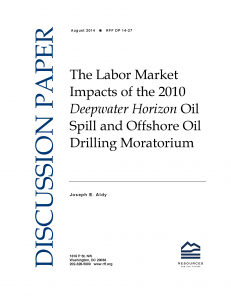 On April 20, 2010, the Transocean Deepwater Horizon suffered a catastrophic blowout while drilling in a BP lease in the Gulf of Mexico’s Macondo Prospect. This accident resulted in the largest oil spill in US history and an unprecedented spill response effort. Due to the ongoing spill and concerns about the safety of offshore oil drilling, the US Department of the Interior suspended offshore deep water oil and gas drilling operations on May 27, 2010, in what became known as the offshore drilling moratorium. The media portrayed the impacts of these events on local employment, with images of closed fisheries, idle rigs, as well as boats skimming oil and workers cleaning oiled beaches.
On April 20, 2010, the Transocean Deepwater Horizon suffered a catastrophic blowout while drilling in a BP lease in the Gulf of Mexico’s Macondo Prospect. This accident resulted in the largest oil spill in US history and an unprecedented spill response effort. Due to the ongoing spill and concerns about the safety of offshore oil drilling, the US Department of the Interior suspended offshore deep water oil and gas drilling operations on May 27, 2010, in what became known as the offshore drilling moratorium. The media portrayed the impacts of these events on local employment, with images of closed fisheries, idle rigs, as well as boats skimming oil and workers cleaning oiled beaches.
In a new RFF discussion paper, “The Labor Market Impacts of the 2010 Deepwater Horizon Oil Spill and Offshore Drilling Moratorium,” I estimate and examine the net impact of the oil spill, the drilling moratorium, and spill response on employment and wages in the Gulf Coast. The spill and moratorium represented unexpected events in the region, and the resulting economic impacts varied within and among the Gulf states. Coastal counties and parishes were expected to bear the vast majority of the burden of these two events, while inland areas were expected to be largely unaffected. The moratorium was expected to affect Louisiana—with significant support of the offshore drilling industry—but not, for example, Florida, which had no active drilling off of its coastline. Beyond the economic impacts, the timing and magnitude of the spill response varied across the states over the course of the spill as well.
This Week in the RFF Library Blog
Each week, we review the papers, studies, reports, and briefings posted at the “indispensable” RFF Library Blog, curated by RFF Librarian Chris Clotworthy.
McKinsey on Sustainability & Resource Productivity — Issue 2, Summer 2014
In this second issue of McKinsey on Sustainability & Resource Productivity, we seek to establish the value of sustainability and to demonstrate how these opportunities can (and are) being captured in a range of industries… – via McKinsey & Company
Scorecard: Conserving the Greater Sage Grouse
[From Press Release] Six conservation organizations today released a detailed scorecard for grading the Obama administration on following federal scientists’ recommendations for conserving greater sage grouse across more than 60 million acres of public land in the American West. The groups also sent a letter to Interior Secretary Sally Jewell and Agriculture Secretary Tom Vilsack urging them to follow specific measures for protecting these imperiled birds as they approve a series of upcoming federal land “management plans” from the Bureau of Land Management and USDA Forest Service… – via Center for Biological Diversity
Draft Addendum to Environmental Review Documents Concerning Exports of Natural Gas from the United States
[Website] The purpose of the Addendum is to provide additional information to the public regarding the potential environmental impacts of unconventional natural gas exploration and production activities. DOE has received many comments related to concerns about the potential impacts from increased development of unconventional natural gas resources in the United States, particularly production that involves hydraulic fracturing. While not required by the National Environmental Policy Act (NEPA), DOE has prepared this Addendum in an effort to be responsive to the public and provide the most current information available… – via US Dept. of Energy
On Proposed Regulations for Arctic Offshore Oil Drilling
This entry previously appeared as a comment on the National Journal’s Energy Insiders forum “Can Arctic Drilling Be Done Safely?”.
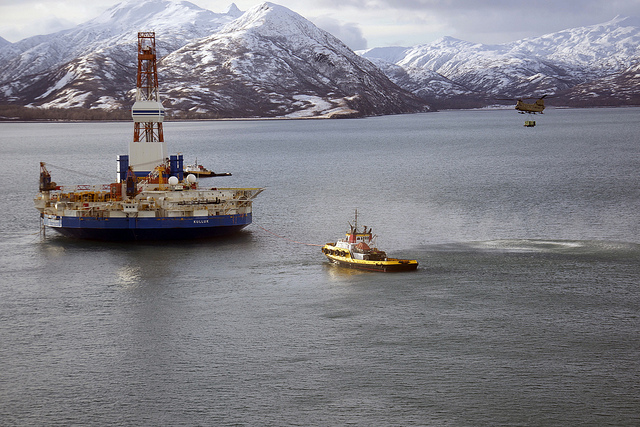
Kulluk Drilling Rig (credit: U.S. Pacific Command / flickr)
On August 15, the Obama administration took a long awaited step forward in the development of safety standards for Arctic offshore drilling operations. The submission of proposed regulations by the Department of the Interior (DOI) to the Office of Management and Budget provides a key juncture to assess the outstanding questions and considerations needed for “safe, responsible, and effective drilling activities on the Arctic Outer Continental Shelf.” My colleague, Katrina McLaughlin, reminds us of a few preliminary points worth making.
Arctic drilling has been occurring for decades and other countries will continue to evolve their energy industry in this region. But the Arctic is undergoing profound change that affects the operating environment. Risk assessment in the Arctic cannot be only retrospective and based on past experience. It must also be forward looking and adaptive to the latest scientific information. The new ice regime is more mobile and unpredictable, wave heights are unprecedented, and coastal erosion and permafrost degradation threaten infrastructure.These new operating parameters will also necessitate large investments from both industry and government—including in polar-class ice breakers, ice-capable drilling rigs, and expanded transportation, communication, and monitoring networks.
Taking Advice: Do Homeowners Follow Up on Home Energy Audits?
This is the second post in a new blog series on our survey of homeowners as part of RFF’s Energy Efficiency Information Initiative. The first post focuses on what’s included in an audit and how much it costs homeowners. In this post, we’ll reveal if people followed their auditors’ recommendations. In the third post, we’ll focus on some differences among homeowners who had an audit versus those who hadn’t.
Consulting an expert can be helpful when faced with certain decisions that require technical expertise. When it comes to assessing and reducing home energy use, professional home energy auditors can be a good source of advice. The most common recommendations from home energy audits are to 1) seal air gaps and, 2) add insulation. Air gaps can be around windows and doors, in attics, and in many nooks and crannies of the home and are often identified during an audit by using a blower door test. The most common area for insulation is the attic but, ideally crawlspaces, walls, and pipes are also insulated. In our 2011 survey of home energy auditors, more than 90 percent said they recommend air sealing and insulation improvements fairly often or always.
In our recent homeowner survey, 67 percent said that their auditor recommended air sealing. Air sealing is the lowest hanging fruit for efficiency improvements in homes. It is usually inexpensive and relatively easy. Moreover, an audit is usually especially helpful for identifying where and how to seal. However, only 41 percent of homeowners in our survey did all the air sealing that was recommended in their audit, 38 percent said they did some, and 21 percent said they had not undertaken any air sealing.
Auditors recommended attic and crawlspace insulation somewhat less frequently; in our case, only 56 percent of homeowners reported receiving such a recommendation from their audits. Of these, about 41 percent said they did all the insulation improvements that were recommended—the same percentage as air sealing. Only 23 percent reported doing some, and 36 percent said they did none of the recommended insulation. New heating, cooling, or water heating equipment was recommended to only 30 percent of the homeowners in our survey who had audits. Interestingly, however, 62 percent of these folks followed up and purchased new equipment.
RFF on the Issues: Carbon tax rebates; China’s shale challenges
Carbon Tax Rebates
A recent poll conducted by USA Today found that taxpayer support for a carbon tax rises “if the money is returned to them.” Only 34 percent of respondents initially said they would back a tax on fossil fuel emissions, but this number rose to 56 percent when polled about carbon tax programs that returned revenue to households in lump sum rebate checks.
New research by RFF’s Rob Williams, Hal Gordon, Dallas Burtraw, Richard Morgenstern, and Jared Carbone from the University of Calgary notes that the cost to the overall economy is higher when carbon tax revenues are returned as lump-sum rebates rather than via tax cuts (an option the poll didn’t include). Nonetheless, the study, which looks at the short-term effects of a carbon tax across income groups, shows that a carbon tax with lump-sum rebates is progressive, and that a majority of households would come out ahead under such a policy (even when ignoring any environmental benefits).
China’s Shale Challenges
China has sharply downgraded its expectations for future shale gas production from between 60 to 80 billion cubic meters (bcm) per year to 30 bcm per year by 2020. The country has the largest estimated proven shale reserves in the world, but “early exploration efforts to unlock the unconventional fuel [have proven] challenging” due to issues involving geology and production costs.
In a new discussion paper, RFF’s Zhongmin Wang and Alan Krupnick and their colleagues from the Energy Research Institute in Beijing suggest that the key to overcoming the innovation barriers for Chinese shale development may lie with the country’s national oil companies (NOCs). They write: “China’s NOCs enjoy overwhelming advantages over new entrants in terms of technology, experience, financial resources, and policy. The question is how to motivate the NOCs to invest in shale gas drilling.” In a blog post, they note that “Much like the US experience, China will need to first lower costs through investments in drilling and other innovations in order to become profitable enough to encourage further capital investment.”
Taking Steps toward Green Growth in China
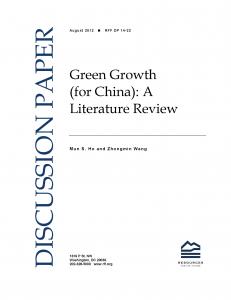 For decades, China’s government has focused on economic growth and has paid less attention to the associated environmental consequences. But today, the need for environmental regulation is more widely recognized as a critical ingredient for continued, sustainable growth in the world’s most populous country. In a new RFF discussion paper, Green Growth (for China): A Literature Review, we examine the concept of green growth in general and take a look at what it means for China to pursue such a path going forward.
For decades, China’s government has focused on economic growth and has paid less attention to the associated environmental consequences. But today, the need for environmental regulation is more widely recognized as a critical ingredient for continued, sustainable growth in the world’s most populous country. In a new RFF discussion paper, Green Growth (for China): A Literature Review, we examine the concept of green growth in general and take a look at what it means for China to pursue such a path going forward.
The concept of green growth, as advanced by various international development organizations and governments, emphasizes environmentally sustainable economic growth. If growth is allowed to proceed with no consideration for the impacts on air and water quality, ecosystem degradation, and biodiversity, for example, the economy will eventually no longer be able to advance without harm to public health or the loss of precious natural resources. The concern over public health impacts in China is very real, with troubling levels of air and water pollution. Only 3 out of 74 large cities in China met official air quality standards in 2013, according to the Ministry of Environmental Protection. Read More
This Week in the RFF Library Blog
Each week, we review the papers, studies, reports, and briefings posted at the “indispensable” RFF Library Blog, curated by RFF Librarian Chris Clotworthy.
Footprint of Deepwater Horizon Blowout Impact to Deep-water Coral Communities
[Significance] The Deepwater Horizon blowout released more oil and gas into the deep sea than any previous spill. Soon after the well was capped, a deep-sea community 13 km southwest of the wellhead was discovered with corals that had been damaged by the spill. Here we show this was not an isolated incident; at least two other coral communities were also impacted by the spill. One was almost twice as far from the wellhead and in 50% deeper water, considerably expanding the known area of impact. In addition, two of four other newly discovered coral communities in the region were fouled with commercial fishing line, indicating a large cumulative effect of anthropogenic activities on the corals of the deep Gulf of Mexico… – via Proceedings of the National Academy of Sciences
A 2015 Global Warming Pact Probably Won’t be Enough to Stop Global Warming: MIT Study
[National Journal] Don’t expect too much from the global climate-change accord that’s expected to emerge from high-stakes international talks in Paris next year. A new MIT study concludes that even if negotiators reach a deal at the United Nations conference, it probably won’t be enough to limit global temperature increases to 2 degrees Celsius above pre-industrial levels. That’s the level many scientists say would help stave off some of the most dangerous and disruptive effects of climate change… – via MIT Joint Program on the Science and Policy of Global Change
The Costs and Quality of Home Energy Audits: What Homeowners Say
This is the first post in a new series on our survey of homeowners as part of RFF’s Energy Efficiency Information Initiative. Here we focus on what’s included in an energy audit and how much it costs. In the second post, we’ll reveal if people followed their auditors’ recommendations. In the third post, we’ll focus on some differences among homeowners who had an audit versus those who hadn’t.
Building scientists and energy efficiency experts have a message for homeowners: there are a number of cost-effective improvements that can lower our energy bills, from simple weather stripping and air sealing to upgrading to a new high-efficiency furnace. But many homeowners don’t know where to begin. They might know they have an old furnace, but they have no idea how effective the attic insulation is, where all the air leaks are, and which improvements are likely to pay off.
This is where home energy audits come in. A professional can determine where a house is losing energy and how to correct the problem. Auditors look for air leaks all around the home, evaluate air ducts for leaks (if the home has ducts), assess insulation in the attic, crawlspace, walls, and around pipes, and evaluate heating, air conditioning, and water heating equipment. They may use special techniques, such as a blower door test to manipulate air pressure in the house and draw air through unsealed cracks and openings, and infrared imaging to show where heat is escaping.
However, only about 4 percent of the homeowners surveyed in the US Department of Energy’s 2009 Residential Energy Consumption Survey reported having an audit recently. Even among people who have had audits, the follow-up with retrofits and improvements is usually incomplete. If energy efficiency investments pay for themselves in energy savings, why aren’t more homeowners taking advantage of these opportunities?
This Week in the RFF Library Blog
Each week, we review the papers, studies, reports, and briefings posted at the “indispensable” RFF Library Blog, curated by RFF Librarian Chris Clotworthy.
PAGES: Public Access Gateway for Energy and Science
[Science Magazine] The U.S. Department of Energy (DOE) today unveiled its answer to a White House mandate to make the research papers it funds free for anyone to read: a Web portal that will link to full-text papers a year after they’re published. Once researchers are up to speed and submitting their manuscripts, that will mean 20,000 to 30,000 new free papers a year on energy research, physics, and other scientific topics. Although the plan will expand public access to papers, some onlookers aren’t happy. That’s because the papers will not reside in a central DOE database, but mostly on journal publishers’ websites. Open-access advocates say that will limit what people can do with the papers… – via US DOE
The Climate Implications of U.S. Liquefied Natural Gas, or LNG, Exports
As the expansion of shale gas production has positioned the United States to become a potential net exporter of natural gas, the overall effect that increased exports would have on the climate has been in dispute. Many aspects of an increased natural gas exports scenario would affect emissions. On the one hand, natural gas could partially displace the use of coal overseas in the generation of electricity. This would put downward pressure on emissions, as natural gas plants on average emit approximately 50 percent less carbon dioxide, or CO2, than coal plants… – via Center for American Progress / by Gwynne Taraska and Darryl Banks

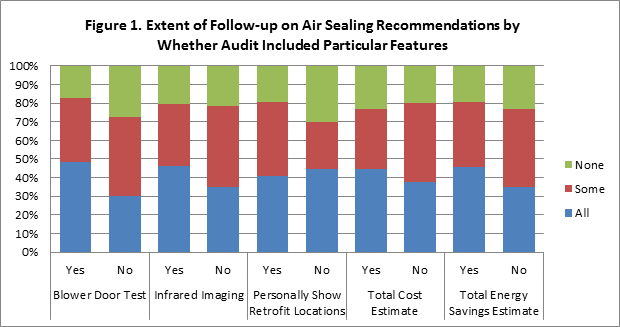
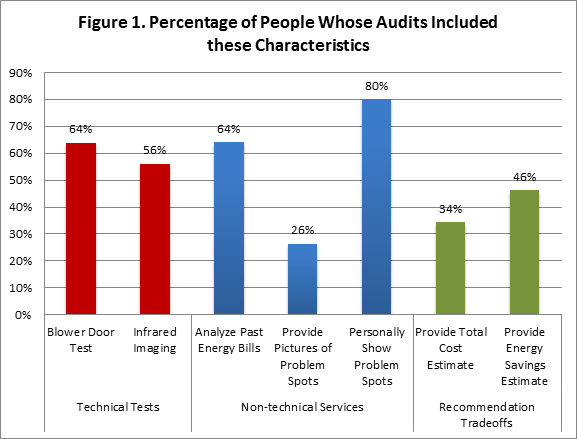
 Subscribe; to our RSS Feed
Subscribe; to our RSS Feed Tweets by @RFF_org
Tweets by @RFF_org 
Recent Comments